 This guide has been written to give you exactly all the information you need to make the right choice for your dental issue.
This guide has been written to give you exactly all the information you need to make the right choice for your dental issue.
Understand what dental implants are
When it comes to replacing missing teeth, implants are certainly by far one of the most reliable long-term solutions. Implant teeth are indeed strong, permanent, pain-free and worry-free.
But first, what are your natural teeth made up of ? They have two parts:
1) The root, which is under the gum and which anchors the tooth to the jaw bone.
2) The crown, which is the white part above your gum and which helps to chew your food.
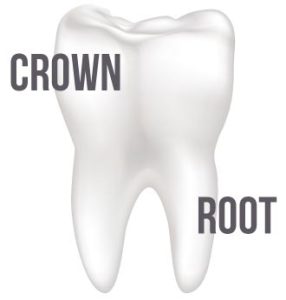 So what is a tooth implant? It is an artificial tooth root that takes the form of a screw shaped titanium post, inserted into the jawbone to replace the root part of a missing tooth and that supports a crown ( the visible part of the “fake” tooth)
So what is a tooth implant? It is an artificial tooth root that takes the form of a screw shaped titanium post, inserted into the jawbone to replace the root part of a missing tooth and that supports a crown ( the visible part of the “fake” tooth)
That is why we call those dental solutions, permanent implants. They are definitely set up to last a lifetime.
The whole tooth implant structure is in fact composed of three main parts:
- Implant – the screw-like material drilled into the jawbone that takes the place of the original tooth root.
- Abutment – the connector that is on top of the implant and serves as a bridge between the implant and the third component, the crown.
- Crown – the replacement tooth often made of dental resin or porcelain, shaped and tinted like a real tooth.
 Implants are typically made of titanium because of its strength and because it is a highly biocompatible material with the body.
Implants are typically made of titanium because of its strength and because it is a highly biocompatible material with the body.
What does biocompatible mean?
Simply that the jawbone believes the titanium implant is a normal tooth root and will grow onto it and fuse with it. This stage is called the osseointegration. The implant is thus firmly integrated into the jawbone as a whole and makes a perfect, stable and permanent anchor for the artificial tooth, which stays in place, unlike removable dentures.
These implants come in varying heights and sizes. The type of implant will depend on your jaw structure ( height, thickness…) and the number of teeth that needs to be replaced.
What are they used for?
If you are looking for information about implants, chances are you have lost one or several teeth. Whatever the cause (accident, decay, disease), implant dentistry is definitely the best option to go for if you need a permanent and reliable tooth replacement solution.
Implants can easily fix issues like:
- A single missing tooth (instead of a bridge)
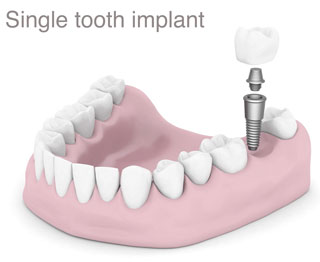
You can replace one single tooth, by having a single implant inserted into the jawbone to replace the missing tooth without touching or using the surrounding healthy teeth. This new tooth will look like and feel like a real natural tooth. The other good thing is it will never decay or need any root canal treatment.
- Multiple missing teeth (instead of partial dentures)
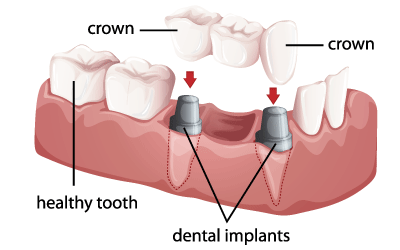
Of course, you can also have more than one tooth to replace. Depending on the position or number of missing teeth, implants can provide an excellent way to replace them. You don’t even need to get one implant for each missing tooth. How? Simply by using implants as support for a fixed bridge. For instance, if you had 3 missing teeth in a row, the dentist could place 2 implants, one on each side of the gap. Then a 3 teeth crown (like a bridge) would be used on top. The middle tooth would not have any implant screw underneath. So you would not need 3 implants but only 2 (more cost effective) and no natural teeth would be used as bridge supports, which could weaken them.
- Full arch of teeth missing (instead of dentures)
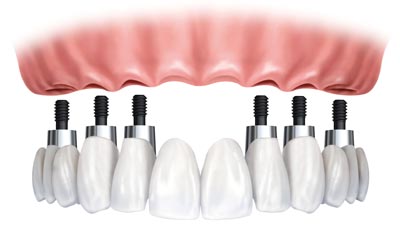 Let’s say you need to replace permanently all your upper or lower teeth (one arch), or even both arches. Like the 3-Teeth Bridge supported by 2 implants, you can get the same replacement process on a larger scale. Implants can support a full arch of upper or lower replacement teeth. Think of a table that is supported by 4 legs. It is exactly the same here. A full arch of 10-12 new teeth can be supported by 4 implants. Yet, there are cases where 4 implants might not be enough and which might need 5 or 6 implants especially if your jawbone is not dense or thick enough. The idea here is to find the most permanent and stable structure that could stand the test of time.
Let’s say you need to replace permanently all your upper or lower teeth (one arch), or even both arches. Like the 3-Teeth Bridge supported by 2 implants, you can get the same replacement process on a larger scale. Implants can support a full arch of upper or lower replacement teeth. Think of a table that is supported by 4 legs. It is exactly the same here. A full arch of 10-12 new teeth can be supported by 4 implants. Yet, there are cases where 4 implants might not be enough and which might need 5 or 6 implants especially if your jawbone is not dense or thick enough. The idea here is to find the most permanent and stable structure that could stand the test of time.
- Help support Removable Dentures
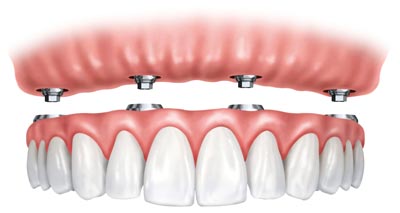 Most traditional dentures rest on the gums, which makes them slip easily when eating or speaking. Sounds familiar? It is pretty difficult and frustrating… Implants can help by making removable dentures more comfortable and effective. How? The dentist would attach the dentures to the implants so dentures would be tightly fixed and secured no matter what you eat.
Most traditional dentures rest on the gums, which makes them slip easily when eating or speaking. Sounds familiar? It is pretty difficult and frustrating… Implants can help by making removable dentures more comfortable and effective. How? The dentist would attach the dentures to the implants so dentures would be tightly fixed and secured no matter what you eat.
Dentures can be fixed with attachments that would snap or clip them in place on the implants. These kind of dentures are often called overdentures. The number of necessary implants will of course vary, as well as the support structure, depending on the design of your denture, your choice of comfort and your budget…
The good thing is there would be no more pressure on the gums directly but on the bone structure, which would help stimulate the bone and help preserve it as is the case when implants are used. This bone preservation is certainly one of the biggest advantage of using implants whether for one, multiple teeth or a full arch.
Are You a tooth Implant Candidate?
 The surrounding teeth and gums should be healthy, as these can affect the success of your teeth implant surgery as well as the ossointegration of the implant itself.
The surrounding teeth and gums should be healthy, as these can affect the success of your teeth implant surgery as well as the ossointegration of the implant itself.
You also need sufficient jawbone material for placing the implants and the density of your jawbone needs to be dense enough to facilitate implant integration.
So if you have any tooth decay, or gum inflammmation with periodontal disease, these will be treated before the procedure.
Most patients with insufficient bone or gum tissue will also require bone grafting or soft tissue grafts to be able to get implants.
Mind you, bone grafting is not always necessary as dentists can offset a lack of bone by using small diameter implants called mini implants.
There is also no age limit except teeth implants can be used only after adolescence or when bone growth is complete. Some medical conditions, such as periodontal disease, active diabetes may also require prior and/or additional treatment before the procedure can be performed
And you need to know that if you are a smoker, your dental surgeon will probably advise you to quit before undergoing the implant procedure since smoking increase the risk of implant failure.
So, the good thing is almost anyone can be a candidate and benefit from implant dentistry. The bad news is for some of you there might be some prior additional treatments or procedures to be able to start the implant procedure itself, which will obviously increase the overall cost.
The initial Consultation : the most important step

Implant preparation includes initial consultation with the tooth implant expert. This is the most important part of the whole process as your dentist will perform a full mouth clinical and radiographic examination, which means they will check:
- Your gums
- Your teeth
- Your jawbone density
- Your jawbone quantity and/or height
Your dentist will need to have x-rays taken from your jawbone and your teeth to establish the most appropriate treatment plan.The x-rays may involve panoramic x-rays as well as CT scans.
Panoramic X-ray gives a pretty complete 2D image of your upper and lower jaws in a single X-ray image. CT scans or CAT scan (called computer tomography) is the most advanced form of X ray which gives a 3D image of your jawbone and teeth, so your dentist can get even more information on your dental case.
The idea here is to get detailed information about your jawbone, upper and lower teeth, and bone structure. It is also important to determine with these scans the height and thickness of your jawbone and the health of your bone, to make sure the implant screws are the right size and avoid any perforation issue. Your dental specialist will also assess the condition of your gums and treat any existing tooth decay. This is to ensure that no further complications will arise once the implant is in place.
Your dental expert also needs to consider your overall health condition. Remember to state upfront if you have existing medical condition or if you are under any medication to avoid possible complications once the operation is underway. Remember also to talk about your concern regarding pain if any so to get reassured.
It is also in the preparation stage that your dentist will take dental impressions of your bite to prepare the dental crown. This will ensure that the new replacement tooth or teeth fit exactly right.
And most dentists also will take a picture of your teeth and smile that will serve a the before picture to be compared with the after picture taken at the end of the dental procedure.
What you need to remember is this consultation and preparation step is definitely the most important one as most failures come from an incomplete examination that missed a vital element before the procedure itself.
The Teeth implant Procedure
The work involved in placing tooth implants is basically divided into 3 parts: implant placement, setting of abutment, and placement of dental crown.

-
Implant Placement
Once you pass all tests and all preparations are complete, you will be ready to have the implant operation. Most people think this is a major operation but it is not, it is a simple outpatient procedure, often performed at your dentist’s office, so you can go home immediately after the procedure.
Will it hurt? well, you will be treated with local anesthesia injected in the area where the operation takes place. So you will probably feel almost nothing. IV sedation can also be used, depending on your condition and the level of comfort you want during the operation.

The dentist will cut the gum to uncover the bone and the implant(s) will be imbedded into the jawbone. When the implant is firmly in place, the gum will be sewed back to close the gap. You may also be provided with temporary dentures, or a protective covering will be placed on top of the sutured gum to protect it from injury when chewing.
The recovery period is anywhere from 3 to 6 months. This allows the implant to join perfectly with your jaw bone in the osseointegration process previously mentioned . When the incision wound has fully healed and the implant has integrated well with your jaw bone, you will return to your dentist for the next step: the implant abutment setting
Note: Most patients who had implants before usually say that they were pretty surprised by this procedure being pain free and that they had only experienced minor discomfort.
-
Abutment Setting
 With local anesthesia, the gum will be cut again to expose the implant underneath and connect the abutment to the implant. The abutment serves as the connecting point between the crown and the implant. Once safely in place, your dentist will suture the gum surrounding the implant abutment, but will leave the abutment protruding in preparation for crown placement.
With local anesthesia, the gum will be cut again to expose the implant underneath and connect the abutment to the implant. The abutment serves as the connecting point between the crown and the implant. Once safely in place, your dentist will suture the gum surrounding the implant abutment, but will leave the abutment protruding in preparation for crown placement.
Juts like the previous operation, you will be allowed to go home and be ready for work the next day. Healing and recovery will take around 14 days before the final procedure.
Why not have the abutment and the implant procedures done at the same time? Yes, that is possible and medical research shows that it can be done. The only challenge is that you will have the abutment protruding through the gum for 3-6 months. This can be pretty uncomfortable and more risky. Because during the healing period, extra care is required to ensure that pressure is not exerted on the abutment and implant to avoid injury and to allow faster healing and faster integration.
Please note that there will be some bruising, swelling, minor pain and bleeding after both implant placement and abutment setting for a few days. Just like any surgical operations, this is perfectly normal. But you will be prescribed medication accordingly.
-
Putting on the Crown
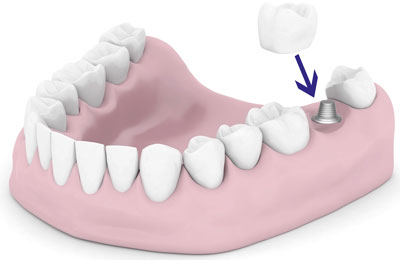 We might as well call this a coronation ceremony because this is the stage where you will get your crown. After months of waiting, your dental crown will finally be connected to the abutment. You will finally have a tooth that look and feel as natural as the one you lost. Now, don’t you feel like a king or a queen?
We might as well call this a coronation ceremony because this is the stage where you will get your crown. After months of waiting, your dental crown will finally be connected to the abutment. You will finally have a tooth that look and feel as natural as the one you lost. Now, don’t you feel like a king or a queen?
Can Implant Surgery be performed in One day?
As I previously mentionned it, dentists can actually set up the implants by combining some steps, which reduces the number of necessary stages. Depending on your jawbone, and your dentist’s choice, you have 3 possibilities:
3-stage procedure: this is the procedure we have just described in the pararaph above, it is the most common procedure, and certainly the safest one as it really gives more recovery time and probably increases the success rate. Of course it is also the most inconvenient one as the procedure would take a longer time, and you would stay longer without the replacement tooth or teeth but it is the safest implant procedure.
2-stage procedure: this is where the step 1 and 2 are combined. Note in this case either the dentist will place the implant and the abutement at the same time. Or in a few cases, the step 2 and 3 could be combined, the dentist can choose to place a longer implant that will protrude trough the gum, so the abutment and crown will be placed at the same time at the end of the procedure. It sure saves you some time but the downside of this 2 step procedure is that the implant by being visible and accessible during the ossointegreation phase, is vulnerable. So any pressure on the implant can interfere with the healing fusion process. That is why the 3 step procedure is safer: the implant is completely underneath the gum and can not be affected by any external forces.

1-stage procedure: this is what we call the one-day dental implants or same day implants, or immediate loading implants. This is not a very common procedure but some surgeons do propose to attach the replacement tooth crown right after placing the implant into the jawbone, or using a fixed denture for the very “impatient” patient. It means a really short treatment time but a much higher risk of incomplete bone fusion due to too much force on the implant during the phase of ossointegration.

From our research, we found out the 3 stage or 2 stage procedure are really the safest procedures. The more steps you combine, the more careful you will need to be to avoid interfering with the bone healing.
The immediate loading can be successful for some cases (usually young patients) and are usually limited to patients with an ideal jaw bone density and quantity, plus a very careful postcare treatment but we definitely prefer to stay on the safe side. A longer treatment but with a higher success rate…. Ok you know we are not really gamblers 🙂
Benefits and risks
Any medical or dental procedures are not without advantages and disadvantages, so it will be best for you to have all these in mind for your decision-making
Benefits
-
Permanent and fixed
Implants are permanent and long-lasting. They are well positioned, fixed, stable and can last for life. You do not need to worry about your teeth dropping or loose parts moving…. Say goodbye to the embarrassment of losing a tooth when eating sticky or tough food.
-
Natural-looking and comfortable
Because they are designed to match your natural teeth and are imbedded, your set of teeth will look natural because implants look, feel and act just like real teeth. You will look better, and feel better about your look and won’t be afraid to smile.
-
Less Maintenance
You don’t need to take them off the same way you would with removable dentures. No more images of dentures soaked in a glass of water. Caring for implants is absolutely the same as caring for regular teeth so take care of implants the same way you take care of your natural teeth and you are good to go.
-
Extremely High Success Rate
With more than almost 50 years of clinical experience and millions of patients treated, implants have a success rate of 95 – 98%. Success rates do depend on many factors ranging from the density, the size of the jaw bone to the dentist skill sets but overall they are well above 95 %. The success rate for lower jaw implants is a bit higher than for upper jaw ones because the lower jaw bone is more dense than the upper jaw bone, which makes osseointegration easier.
-
Independent from surrounding teeth
They are stand-alone solutions that will not use any other teeth in the mouth to support or hold them in place, which keeps any remaining teeth healthy. So no need to grind down adjacent teeth for a bridge, or securing a partial denture to other healthy teeth with clasps that can eventually loosen the natural teeth.
-
Preserve the jaw bone
Without the root structure of a natural tooth present, the jawbone can shrink and melt away progressively (called bone resorption). Implants actually help to preserve the jaw bone because they provide the stimulation that was previously provided by natural tooth roots. So it helps to keep the integrity of your jawline and facial structure.
Risks
-
Failure of the Implant to Bond with the Bone
Although rare, there are instances when the implant will not fuse with the bone naturally in the osseointegration stage phase. It can be due to a pre-existing or post-operative infection, or the formation of a thin fibrous capsule around the implant that prevent the jawbone from growing onto it. These failures can generally be retreated by removing the implant, cleaning the area, letting the bone heal and repeating the implant procedure.
-
Damage to nerves situated near the sinus cavity and adjacent muscles.
Hey, this is a surgery but a minor one. There always is a chance that damages will happen when your body part is cut with a knife, let alone having a foreign object drilled down to your bone. The thorough preparation before the start of the operation, including the various scans made on your mouth and teeth to check the nerve position lessens the risk of injury to the nerves during the actual implant operation.
-
Simply Too Costly
Oh yes, having implants is not like buying a chocolate bar—it is a significant investment. There are a number of factors that make implant expensive, you can check them in our complete implants cost guide. However, many patients find the price of implants cost-effective because this solution gives them the benefit of having a set of teeth that are close to the natural ones. Besides, all the pros make this solution outweigh the other dental alternatives in the long run for most cases.
Different types of implants
 Dentists has more than 70 manufacturers of implants and materials to choose from for their patient implants; so basically they have many different options for each implant element (implant, abutment and crown) at their disposal, to combine and create the best implant to suit their patient needs.
Dentists has more than 70 manufacturers of implants and materials to choose from for their patient implants; so basically they have many different options for each implant element (implant, abutment and crown) at their disposal, to combine and create the best implant to suit their patient needs.
-
Implants: different surface types, sizes and material
a) Surface types
Titanium is the preferred material for implant because of its inherent stability, strength and durability. What differs among titanium implants is how its surface that touches the bone is treated. Usually, the surface of the implant is porous to allow faster implant-to-bone integration in the osseointegration process. This process will take a longer time to complete if the surface finish is smooth…There are also other types of surface treatment for implants that include:
-Roughened surface through acid-etching or grit-blasting
-Hydroxyapatite coating using plasma spray
-Titanium surface using plasma spray or micro-grooving
This is certainly too technical, so simply remember this: the bone needs to grow onto the implant by grabbing whatever it can, so a rough surface is way better than a smooth surface.
b) Sizes
Sizes for implants are also called platforms. The sizes enable the implants to match the patient’s bone density and availability:
-Standard platform: usually used in the frontal area of the mouth and has a diameter of 3.5 mm up to 4.2 mm.
-Wide platform: Often used for the molar teeth area and has a diameter of 4.5 mm up to 6.0 mm.
-Narrow or mini platform: this is what we call the mini implants. They are used for patients with insufficient density or without enough space to accommodate regular sized implant. It has a minimum diameter of 2 mm and maximum of 3.5 mm.
c) Material
Most implants are made from titanium but we also can find implants produced from zirconia ( ceramic, which is an oxide of zirconium). These zirconia implants are well suited to patients with an allergy to titanium or patients who want metal free implants in their mouth.
-
Abutments between the implant and the crown
There are also many different types depending on size and material. They are usually made of titanium but we can also find abutments in ceramic ( zirconia ) or even gold (yes, as gold abutment is said to be best suited for ceramic or porcelain crowns, for a more natural tooth shade with light getting through the crown).
-
Crowns
Crowns can be made up of different materials: steel, metal, porcelain fused to metal, all ceramic and all resin. As you can imagine, prices won’t be the same for each material. The most affordable is the resin option but all resin crowns are less durable and less resistant to the chewing forces.
How Long will the whole implant procedure take?
Treatment time will obviously vary depending on the choice of the dental procedure (3 steps, 2 steps or 1 step) but also on the healing time your bone needs to fully integrate the implants. This length of healing time will affect your overall treatment time for the 2 and 3 stage procedures, because the dentist will wait for your bone to be fully healed before moving on to the next phase. This won’t be the case for the immediate loading procedure, as the dentist won’t wait for the ossointegration in this case.
For some cases, when bone density is not enough, an additional procedure is necessary before the implant procedure: bone grafting. This will lead to an additional healing period for the jawbone before the implant can be placed;
So without bone grafting, the whole procedure for 2 or 3 steps usually requires 4-6 months. If you need prior bone grafting then you would probably need 9-12 months in total (bone grafting +implant)
What type of maintenance do implants require?
Implants are very similar to natural teeth. They simply require the same maintenance as for natural teeth, which means good daily oral hygiene with meticulous brushing and flossing. You will also need to see your dentist once a year or maybe less for regular check ups of your implants and the surrounding bone. Yeah the good thing is that most patients even forget they have implants…
Who Can Perform teeth Implant Operation?
 Professional dental organizations like the American Academy of Periodontology and the American Association of Oral and Maxillofacial Surgeons or similar organizations in your country provide dental practitioners with extensive implant training. Surgical procedures are part of the training of periodontists and oral surgeons. General dentists can also perform the same procedure provided that they have undergone the required training and education.
Professional dental organizations like the American Academy of Periodontology and the American Association of Oral and Maxillofacial Surgeons or similar organizations in your country provide dental practitioners with extensive implant training. Surgical procedures are part of the training of periodontists and oral surgeons. General dentists can also perform the same procedure provided that they have undergone the required training and education.
The success and the result of your implant will highly depend on the dental professional who will perform the operation. It is therefore very important that you ask them about their knowledge and experience about tooth implant procedure. Please note that dentists or other dental service providers are not required to get a license to practice implant dentistry as this is considered a specialization. Hence, you can choose to have an oral surgeon perform the drilling and placement of the implant, then have a general dentist to attach the abutment and the crown.
On that note, you have to be aware that dental practitioners get their supply of implant supplies from different manufacturers (remember, the more than 60 manufacturers we mentioned in the beginning). This may prove difficult when it comes to matching the components used if several dentists perform the different parts of the implant procedure. So you ‘d better stick to only one dental expert for the whole procedure.
How much do implants cost?
As you can imagine, the fees involve many different factors such as the number of teeth to be replaced, the additional procedures required etc… To get a complete list of prices, please check our super duper guide on implant costs, (per tooth, full mouth) with the factors that affect the total cost.
The required budget can be pretty high and some might have trouble to afford them but there are a few ways to get cheaper implants that are really worth exploring, so make sure to check our article explaining 10 ways to get affordable implants.
It will require you to work a little but frankly it may be worth it at the end to go the extra mile to get those.
Thank you for the information. Wish implants were cheaper.
hi raleigh, yeah me too 🙂